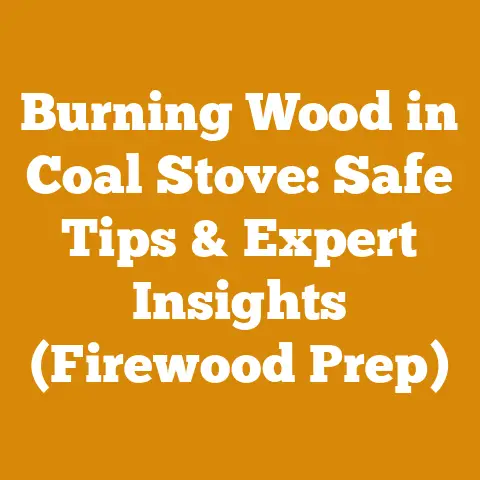What Should the Flame Look Like in a Pellet Stove? (Burn Pot Fire Dance Explained)
As winter’s chill deepens and the scent of woodsmoke fills the air, many of us turn to the comforting warmth of a pellet stove. It’s a modern, efficient way to heat our homes, but understanding how it works – especially the “fire dance” within the burn pot – is crucial for optimal performance and safety. I’ve spent years working with wood, from felling trees in the forest to processing firewood and, yes, troubleshooting pellet stoves. Through this experience, I’ve learned that a properly functioning pellet stove isn’t just about pushing a button; it’s about understanding the nuances of combustion and airflow. In this guide, I’ll share my knowledge to help you decipher the flames in your pellet stove, ensuring a warm and worry-free winter.
What is the “Fire Dance”? Key Concepts Explained
The “fire dance” refers to the dynamic interplay of flames, air, and fuel within the burn pot of your pellet stove. It’s a delicate balance that, when properly tuned, results in a clean, efficient burn. To understand this dance, let’s define some key concepts:
- Burn Pot: This is where the magic happens. It’s the combustion chamber where pellets are ignited and burned.
- Auger: The auger is a screw-like mechanism that feeds pellets from the hopper into the burn pot.
- Airflow: Air is essential for combustion. Pellet stoves use fans to control the amount of air entering the burn pot. This airflow helps to ignite the pellets and sustain the flame.
- Combustion: The process of burning fuel. In a pellet stove, combustion involves the rapid oxidation of wood pellets, releasing heat and light.
- Exhaust: The byproducts of combustion, including smoke, gases, and ash, are vented out of the stove through the exhaust system.
- Ash: The non-combustible residue left behind after the pellets have burned.
The Ideal Pellet Stove Flame: What to Look For
So, what does a healthy “fire dance” look like? Here’s a breakdown of the characteristics of an ideal pellet stove flame:
- Color: The flame should be bright yellow or orange, with a slight blue tinge near the base. This indicates complete combustion and efficient burning.
- Shape: The flame should be active and lively, dancing and flickering within the burn pot. It shouldn’t be lazy, smoky, or stagnant.
- Size: The size of the flame should be appropriate for the stove’s heat setting. A higher setting should produce a larger flame.
- Movement: The flame should be dynamic, with movement indicating proper airflow and fuel distribution.
- Smoke: There should be minimal to no visible smoke coming from the exhaust vent. Excessive smoke indicates incomplete combustion.
- Ash: The ash should be light gray or white in color and powdery in texture. Dark, clumpy ash can indicate poor fuel quality or incomplete combustion.
Troubleshooting Common Flame Problems: A Step-by-Step Guide
Sometimes, the “fire dance” can go awry. Here’s a guide to troubleshooting common flame problems:
1. Weak or Smoky Flame:
- Possible Causes:
- Poor Airflow: This is the most common cause of a weak or smoky flame.
- Poor Quality Pellets: Damp or low-quality pellets can burn poorly.
- Clogged Burn Pot: Ash buildup can restrict airflow and hinder combustion.
- Faulty Auger: If the auger isn’t feeding pellets properly, the flame can weaken.
- Insufficient Draft: A weak chimney draft can prevent proper exhaust and lead to a smoky flame.
- Troubleshooting Steps:
- Clean the Air Intake: Locate the air intake on your stove (usually on the back or side) and clean it thoroughly. Use a vacuum cleaner or brush to remove dust and debris.
- Clean the Burn Pot: Regularly clean the burn pot to remove ash and clinkers (hardened ash deposits). I recommend doing this at least once a week, or more frequently if you burn a lot of pellets.
- Check the Exhaust Vent: Ensure the exhaust vent is clear of obstructions. Birds’ nests, leaves, or snow can block the vent and restrict airflow.
- Inspect the Auger: Visually inspect the auger to ensure it’s turning freely and feeding pellets consistently. If it’s jammed or damaged, you may need to repair or replace it.
- Try Different Pellets: Experiment with different brands or types of pellets to see if the flame improves. Look for pellets that are certified by the Pellet Fuels Institute (PFI).
- Check the Draft: If you suspect a draft problem, consult with a qualified chimney sweep to inspect and clean your chimney.
- Personal Experience: I once had a client who was constantly complaining about a smoky flame. After checking all the usual suspects, I discovered that their chimney cap was clogged with pine needles. Once I cleaned it out, the stove worked like a charm.
2. Tall, Lazy Flame:
- Possible Causes:
- Excessive Airflow: Too much air can cause the flame to become tall and lazy, leading to inefficient burning.
- Overfeeding Pellets: If the auger is feeding too many pellets, the flame can become smothered.
- Troubleshooting Steps:
- Adjust the Airflow: Most pellet stoves have an adjustable air intake. Try reducing the airflow to see if the flame improves.
- Reduce the Feed Rate: If your stove has a feed rate adjustment, try reducing the amount of pellets being fed into the burn pot.
- Check the Auger Calibration: Some stoves require the auger to be calibrated. Consult your owner’s manual for instructions on how to calibrate the auger.
3. Flame Going Out:
- Possible Causes:
- Lack of Fuel: The most obvious cause is running out of pellets in the hopper.
- Auger Problems: A malfunctioning auger can stop feeding pellets, causing the flame to go out.
- Airflow Problems: Insufficient airflow can extinguish the flame.
- Faulty Igniter: The igniter is responsible for starting the fire. If it’s faulty, the stove may not be able to light the pellets.
- Troubleshooting Steps:
- Refill the Hopper: Ensure there are enough pellets in the hopper.
- Check the Auger: Inspect the auger to ensure it’s turning and feeding pellets.
- Clean the Air Intake: Ensure the air intake is clean and unobstructed.
- Check the Igniter: If the stove is failing to ignite, consult your owner’s manual for instructions on how to test the igniter. You may need to replace it.
4. Excessive Ash Buildup:
- Possible Causes:
- Poor Quality Pellets: Low-quality pellets often contain more ash.
- Incomplete Combustion: Inefficient burning can lead to excessive ash buildup.
- Improper Airflow: Insufficient airflow can contribute to incomplete combustion and ash buildup.
- Troubleshooting Steps:
- Use High-Quality Pellets: Switch to a higher-quality pellet brand.
- Optimize Airflow: Ensure the airflow is properly adjusted for optimal combustion.
- Clean the Stove Regularly: Clean the burn pot, ash pan, and exhaust vent regularly to remove ash buildup.
The Importance of Pellet Quality: Choosing the Right Fuel
The quality of your pellets has a significant impact on the performance of your pellet stove. Here’s what to look for when choosing pellets:
- Certification: Look for pellets that are certified by the Pellet Fuels Institute (PFI). PFI certification ensures that the pellets meet certain standards for moisture content, ash content, and heating value.
- Ash Content: Lower ash content is generally better, as it reduces the amount of ash you’ll need to clean out of your stove.
- Moisture Content: Pellets should have a low moisture content (typically less than 8%). Damp pellets burn poorly and can produce more smoke and ash.
- Wood Species: Different wood species have different heating values. Hardwood pellets (like oak or maple) generally have a higher heating value than softwood pellets (like pine or fir).
- Appearance: Good quality pellets should be uniform in size and shape, with a smooth, clean surface. Avoid pellets that are cracked, broken, or dusty.
I’ve found that investing in higher-quality pellets is almost always worth it in the long run. You’ll get better heat output, less ash, and fewer problems with your stove. I once tried to save money by buying a pallet of cheap, uncertified pellets. They burned poorly, produced a ton of ash, and clogged my stove’s auger. I ended up spending more time cleaning the stove than I did enjoying the heat.
Regular Maintenance: Keeping Your Stove Running Smoothly
Regular maintenance is essential for keeping your pellet stove running efficiently and safely. Here’s a checklist of maintenance tasks:
- Daily: Empty the ash pan.
- Weekly: Clean the burn pot and scrape away any clinkers.
- Monthly: Clean the air intake and exhaust vent.
- Annually: Inspect and clean the chimney (or have it professionally cleaned). Inspect and lubricate the auger motor. Inspect and clean the blower motor.
Consult your owner’s manual for specific maintenance instructions for your stove model.
Safety First: Essential Precautions for Pellet Stove Operation
Pellet stoves are generally safe appliances, but it’s important to follow these safety precautions:
- Install a Carbon Monoxide Detector: Carbon monoxide is a colorless, odorless gas that can be deadly. Install a carbon monoxide detector near your pellet stove and test it regularly.
- Keep Flammable Materials Away: Keep flammable materials (like curtains, furniture, and paper) at least 3 feet away from the stove.
- Never Use Flammable Liquids: Never use gasoline, kerosene, or other flammable liquids to start or fuel the stove.
- Supervise Children and Pets: Keep children and pets away from the stove when it’s in operation.
- Have Your Stove Professionally Inspected: Have your stove professionally inspected and serviced at least once a year.
- Read the Owner’s Manual: Familiarize yourself with the operating instructions and safety precautions in your owner’s manual.
Advanced Tips for Optimizing Pellet Stove Performance
Once you’ve mastered the basics of pellet stove operation, here are some advanced tips for optimizing performance:
- Experiment with Different Settings: Most pellet stoves have adjustable settings for airflow, feed rate, and temperature. Experiment with these settings to find the optimal combination for your home and your heating needs.
- Use a Thermostat: A thermostat can help to maintain a consistent temperature in your home and prevent the stove from overheating.
- Consider a Programmable Thermostat: A programmable thermostat allows you to set different temperatures for different times of day, saving energy and money.
- Insulate Your Home: Proper insulation can help to reduce heat loss and improve the efficiency of your pellet stove.
- Seal Air Leaks: Seal any air leaks around windows, doors, and other openings to prevent drafts and heat loss.
- Use a Fan to Circulate Heat: A fan can help to circulate heat throughout your home, making it more comfortable and efficient.
Pellet Stoves and Firewood: A Complementary Approach
While pellet stoves offer convenience and efficiency, they don’t replace the primal appeal of a wood-burning fireplace. In my experience, many homeowners use pellet stoves as their primary heating source and supplement them with occasional wood fires for ambiance and enjoyment. Understanding both pellet stoves and firewood preparation can create a well-rounded heating strategy.
Firewood Preparation Basics:
- Wood Selection: Choose hardwoods like oak, maple, and ash for their high heat output. Avoid softwoods like pine and fir, as they burn quickly and produce more smoke.
- Seasoning: Season your firewood for at least six months to reduce its moisture content. Seasoned wood burns hotter, cleaner, and more efficiently. Green wood can be as much as 50% moisture content or more. Aim for 20% or less. I use a moisture meter to test the wood before burning.
- Splitting: Split your firewood into manageable sizes. Smaller pieces ignite more easily and burn more quickly.
- Stacking: Stack your firewood in a way that allows for good airflow. This will help it to dry more quickly and prevent rot. I prefer to stack my wood in rows, with gaps between the rows for ventilation.
- Tools: A good axe or log splitter is essential for firewood preparation. I personally prefer a hydraulic log splitter for larger volumes of wood. A chainsaw is also useful for cutting logs to length.
Combining Pellet Stoves and Firewood:
- Use a Pellet Stove for Consistent Heat: Rely on your pellet stove for consistent, efficient heating throughout the day.
- Enjoy Wood Fires for Ambiance: Light a wood fire in the evening for ambiance and enjoyment.
- Use Firewood as a Backup: Keep a supply of seasoned firewood on hand as a backup heating source in case of a power outage or pellet stove malfunction.
Case Study: Optimizing a Pellet Stove System for a Mountain Cabin
I was recently contacted by a homeowner in the mountains who was struggling to heat their cabin with a pellet stove. The cabin was poorly insulated, and the stove was constantly running, consuming large amounts of pellets. Here’s how I helped them optimize their system:
- Insulation Assessment: I conducted a thorough insulation assessment of the cabin. I found that the walls and roof were poorly insulated, and there were significant air leaks around the windows and doors.
- Insulation Upgrades: I recommended adding insulation to the walls and roof, and sealing the air leaks. This significantly reduced heat loss and improved the efficiency of the pellet stove.
- Stove Optimization: I cleaned and inspected the pellet stove, ensuring that it was operating properly. I also adjusted the airflow and feed rate settings to optimize combustion.
- Pellet Selection: I recommended switching to a higher-quality pellet brand with a lower ash content.
- Results: After implementing these changes, the homeowner reported a significant improvement in the cabin’s heating performance. The pellet stove consumed fewer pellets, and the cabin was much more comfortable.
This case study highlights the importance of a holistic approach to pellet stove optimization. It’s not just about the stove itself; it’s also about the insulation, air sealing, and pellet quality.
The Future of Pellet Stoves: Innovations and Trends
The pellet stove industry is constantly evolving, with new innovations and trends emerging all the time. Here are some of the key trends to watch:
- Smart Stoves: Smart pellet stoves can be controlled remotely via smartphone apps. They can also be programmed to automatically adjust their settings based on the weather or your heating preferences.
- High-Efficiency Stoves: Manufacturers are developing more efficient pellet stoves that burn less fuel and produce less emissions.
- Multi-Fuel Stoves: Some pellet stoves can burn a variety of fuels, including wood pellets, corn, and other biomass materials.
- Improved Air Filtration: New pellet stoves are equipped with advanced air filtration systems that remove dust, pollen, and other allergens from the air.
- Sustainable Pellets: There’s a growing demand for sustainably sourced pellets made from recycled wood waste or other renewable resources.
Strategic Insights for Pellet Stove Owners
Beyond the technical aspects, there are strategic advantages to understanding and optimizing your pellet stove system.
- Cost Savings: Efficient pellet stove operation can significantly reduce your heating bills.
- Environmental Benefits: Burning pellets is a more environmentally friendly alternative to fossil fuels.
- Increased Home Value: A well-maintained and efficient pellet stove can increase the value of your home.
- Peace of Mind: Knowing that your pellet stove is operating safely and efficiently can give you peace of mind, especially during the cold winter months.
- Self-Reliance: Understanding how to troubleshoot and maintain your pellet stove can make you more self-reliant and less dependent on outside help.
Practical Next Steps: Getting Started with Pellet Stove Optimization
Ready to take your pellet stove knowledge to the next level? Here are some practical next steps you can take:
- Read Your Owner’s Manual: This is the best source of information about your specific pellet stove model.
- Inspect and Clean Your Stove: Regularly inspect and clean your stove to ensure that it’s operating properly.
- Experiment with Different Pellets: Try different brands and types of pellets to find the ones that work best for your stove.
- Adjust Your Settings: Experiment with the airflow, feed rate, and temperature settings to optimize combustion and heat output.
- Monitor Your Flame: Pay attention to the color, shape, and movement of the flame in your burn pot. This will give you valuable clues about the stove’s performance.
- Consult with a Professional: If you’re having trouble troubleshooting your pellet stove, don’t hesitate to consult with a qualified technician.
- Join a Pellet Stove Forum: Online forums can be a great resource for learning from other pellet stove owners and getting advice on troubleshooting and maintenance.
Final Thoughts: Embracing the Warmth and Efficiency of Pellet Stoves
Pellet stoves offer a convenient, efficient, and environmentally friendly way to heat our homes. By understanding the “fire dance” in the burn pot, choosing the right fuel, and performing regular maintenance, we can ensure that our pellet stoves operate safely and efficiently for years to come. I hope this guide has provided you with the knowledge and tools you need to master your pellet stove and enjoy the warmth and comfort it provides. Remember to always prioritize safety and consult with a qualified professional if you have any concerns. Now, go forth and enjoy the “fire dance”!






